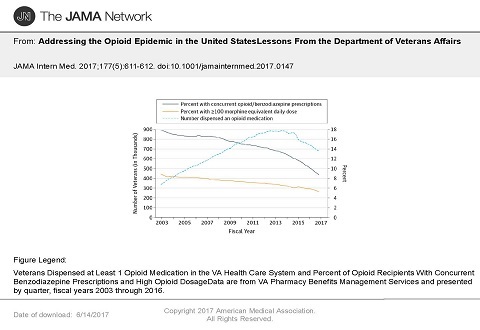Center for Health Equity Research and Promotion
Addressing Opioid Epidemic in US

Graphic from JAMA Internal Medicine May 2017 issue. "Viewpoint" by CHERP Investigators Walid Gellad, MD, MPH and Chester Good, MD, MPH, and VA Secretary David Shulkin, MD.
Addressing the Opioid Epidemic in the United States
Lessons From the Department of Veterans Affairs
CHERP Investigators Walid Gellad, MD, MPH and Chester B. Good, MD, MPH published a “Viewpoint “with David Shulkin, MD, Secretary of the Department of Veterans Affairs, in the May 2017 issue of Journal of the American Medical Association (JAMA) Internal Medicine.
BACKGROUND:
Over the last 15 years, more than 165,000 people in the U.S. have died from overdoses related to prescription opioids, and millions more have suffered adverse consequences. Because chronic pain impacts half of Veterans, complicated by high rates of psychiatric comorbidities (i.e., substance use disorder and PTSD), the VA Healthcare System also is affected by this epidemic. For example, by 2012 nearly one-quarter of all Veterans receiving VA outpatient care also were receiving an opioid. So in 2013, VA launched the Opioid Safety Initiative (OSI), the first of several system-wide initiatives to address opioid overuse. As a result, by mid-2016 the number of Veterans dispensed an opioid each quarter had decreased by 172,000, or about 25%. In 2017, even fewer Veterans are receiving high doses of opioids or concomitant interacting medicines like benzodiazepines, and more Veterans are receiving non-opioid pain therapies, naloxone, and treatment for substance use disorders. This article describes VA’s efforts to address the opioid epidemic, and the lessons learned that can inform other healthcare systems planning comprehensive action to reduce the risks associated with opioid therapy.
SUMMARY:
VA has employed four broad strategies to address the opioid epidemic: Education, Pain Management, Risk Mitigation, and Addiction Treatment. The educational initiatives include academic detailing, educational programming, and an informed consent requirement for VA patients who are prescribed chronic opioid therapy. As part of its efforts to improve pain management, VA issued a policy directive for stepped pain care, emphasizing interdisciplinary teamwork as a delivery model for pain management. VA also expanded ‘mini-residency’ programs and telemedicine consult capabilities for primary care clinicians to improve their management of pain. VA implemented several strategies to support and track risk mitigation activities for opioid therapy; for example, a Stratification Tool for Opioid Risk Mitigation (STORM) uses predictive modeling to estimate the risk of overdose or suicide-related event for each VA patient on opioids. VA also has an extensive system for addiction treatment through inpatient and outpatient care. In addition, VA has an extensive residential program for long-term addiction treatment that served nearly 15,000 Veterans in 2015.
VA has made progress and important lessons have been learned. For example, the balance between appropriately treating pain and reducing the risks of opioid use requires careful attention. In some cases this means reducing the number of patients receiving opioids, but in other cases it means improving the safety of opioid use among those who require such medications. Also, in capturing regional and clinician-specific data, VA can identify both ‘best practices’ and outliers on which to focus its efforts. Although national policies addressing opioid use are important, local action has been the real driver of change. More accessible and real-time data on overdose death would improve VA’s ability to identify any unintended consequences of its efforts to reduce prescription opioid use.
AUTHOR/FUNDING INFORMATION: This study was funded by VA HSR&D. Drs. Gellad and Good are part of HSR&D’s Center for Health Equity Research and Promotion (CHERP) in Pittsburgh, PA. Dr. Shulkin is Secretary for Veterans Affairs.



















